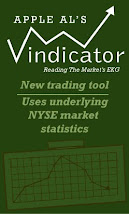Today was a continuation of yesterday's choppy and overlapping activity, but with more volatility. The pattern since Monday's highs still qualifies as a wave 2 to Friday's wave 1. However, if we don't rally steadily from here that whole count becomes questionable as the supposed wave 2 will be extending a little too far in time to be reasonable.
The long ES from Friday has been held through the choppiness of the last two days. Which brings up a subject: retracements versus changes in trend. Markets never go in straight lines, there always is backing and filling along the way. When an apparent change of trend occurs there will be an almost inevitable retrace early on. However, sometimes that retrace itself turns into a change of trend. So how does one distinguish between the two? More importantly, when should a move opposite to the preceding direction be traded?
The Trend/Osc system has a rule which uses the 14 day value of Wilder's ATR. The rule is that a move opposite an existing trend is to be considered a change of trend only if the existing trend has moved a minimum of two 14 day ATR's from it's start point or the start of the change in direction occurs more than two days from the existing trend's start point.
Applying this to today and yesterday it works out as follows:
14 day ATR = ES 17.00 points
Start of uptrend = Thursday between 2 & 3 PM
Low preceding uptrend = 1117.25
ATR test: 2 ATR's above 1117.25 = 1117.25 + 34.00 = 1151.25, market topped at ES 1149.75 Sunday night so did not exceed that trigger;
Time test: 2 trading days from 2 PM bar on Thursday is 2 PM bar on Monday, market topped Sunday night so did not exceed time trigger -
-therefore-
Selling on Monday and Tuesday is to be treated as a retracement rather than a change in trend, so continue to hold long (unless stopped out) even though there was a Trend/Osc sell signal today.




I looked at the situation a little differently. I agree that the Monday-Tues down days will not reverse the trend:
ReplyDeletehttp://instigator928.blogspot.com/
The ATR usage mentioned is not designed to predict anything, it's designed to avoid whipsaws at the start of a trend. In your example, if you're referring to the e-mini S&P in early January that marked a bearish trend reversal, then 2 ATR's would be subtracted from the high print to determine the retrace/trend reversal decision point. I can try a better explanation if you need it, I'm not sure we're on the same page here.
ReplyDeleteI also love math, although I didn't major in it I had a math professor who begged me to change my major to math. Alas, that was almost 40 years ago (I'm an old geezer) and I've long since forgotten the finer points of Trig and Calculus and etc.